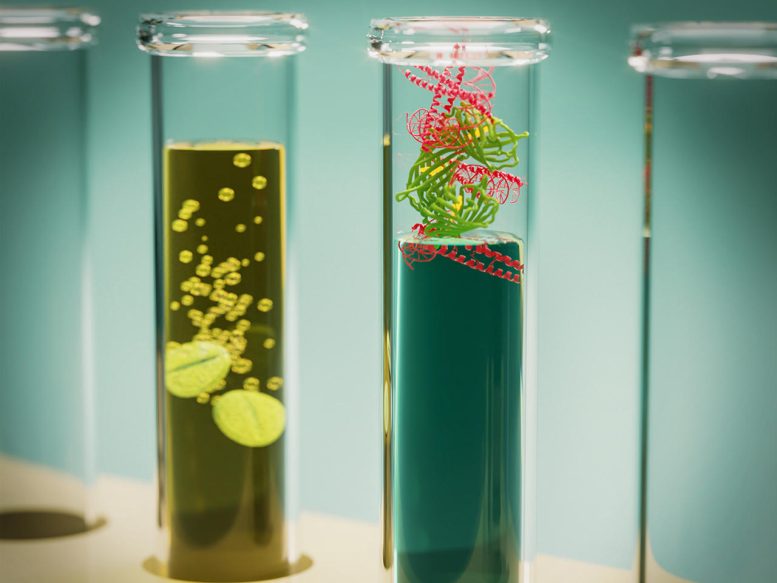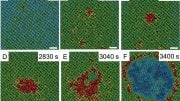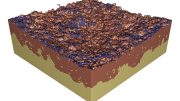
Graphical representation of tablets of solid-state biologics dissolving in water (left), activating the biological machinery for on-demand manufacturing (right). Credit: Designed by Ehsan Faridi and Ehsan Keshavarzi (Inmywork Studio)
The breakthrough has potential applications in health care and scientific research.
Researchers have developed a new technique to store biological substances like RNA and proteins in a solid form. This solid-state storage resembles the form of a pill or tablet, which can be dissolved in water when needed. This groundbreaking approach addresses prevailing challenges in preserving and managing products extracted from living cells, vital for various medical and scientific research endeavors.
Biological materials, essential in creating new drugs and tools for diagnostic tests, such as mRNA, enzymes, and antibodies, are notably vulnerable to variations in environmental conditions during storage, transit, and usage. Improper storage and handling can lead them to deteriorate or lose their functionality, posing significant barriers to their availability in regions with limited resources or those that are underserved.
For example, the Pfizer COVID vaccine rollout was limited in speed and breadth due to the need for deep freezers for storage and transport. More broadly, even when refrigeration infrastructure is present, failures occurred in over 10% of cases, resulting in over $35 billion in losses annually according to IQVIA Institute for Human Data Science.
To overcome some of the key limitations, researchers at California Polytechnic State University (Cal Poly) in San Luis Obispo, CA, have developed a new method for storing biological materials with vast potential for use by the scientific and medical communities.
When most of us open our medicine cabinets, we find pharmaceutical drugs stored in forms such as liquids, powders packaged in capsules, pills, and tablets. Pharmaceuticals have proven that each form plays an important role in how the medication is stored and used.
Apart from a few exceptions, biological materials such as medications, are currently limited to being stored as frozen or refrigerated liquids and freeze-dried powders. The absence of a tablet-like form has limited the field, often making it challenging to reach the locations and users where they are needed.
“Just as tablets have changed the way we take medications, the solid-state storage platform opens new possibilities for how we handle and use biological materials, unlocking the potential for existing therapies and emerging biotechnologies,” said Dr. Javin Oza, associate professor in chemistry and biochemistry, who led the research on the new storage platform.
Most biological materials require storage as liquids which are frozen in deep freezers for the duration of their shelf life. As a society, we accomplish this through a complex and integrated system of refrigerators and freezers, known as the cold-chain. In recent years, many research teams, including the group at Cal Poly have made progress in freeze-drying biological materials, which has improved the way they are stored and handled, but the use of freeze-drying remains limited.
The solid-state storage of biologics represents the next big step because tablets provide unique advantages to better preserve the material they encapsulate. For example, the innovation allows researchers to be able to package biological materials into tablets that can be stored on a shelf at room temperature, and added to water to be dissolved for on-demand use. In addition to ensuring the stability and activity of the biological materials, solid-state storage has been developed to ensure that tablets quickly disintegrate and dissolve into water.
“Our innovation makes storing and using biologics as easy as an Alka-Seltzer tablet, just drop it into water, mix, and it’s ready to go,” Oza added.
As a test case for the solid-state storage platform’s ability to support a complex mixture of biologics, the team demonstrated that the cell’s machinery capable of decoding genetic information into making RNA and proteins can be stored in a solid-state. When added to water, the machinery reactivates to decode genetic information as if it were still within the cell. The team also went a step further to demonstrate that emerging biotechnology tools such as CRISPR can be activated after storage in a solid-state.
The team’s results demonstrate potential for a wide range of applications. The ability to store biologics at room temperature and activate them on demand could be useful for delivering therapeutics to remote locations where the cold-chain is unavailable. For instance, one could envision portable, on-demand production of vaccines in remote locations. The platform could also be used for diagnostic testing of anything from COVID-19 screening to testing wastewater contaminants, simply by changing the composition of the tablets. For utilization in the field, the solid-state storage has the added benefit of being simple to use, reducing the need for specialty training of technicians, further improving access at the point of need.
Further improvements to the platform will be needed to suit specific use cases. The researchers anticipate that additional modifications such as coatings could help the solid-state storage be more suitable for withstanding extreme environments such as heat, humidity, and chemicals. Additionally, continued improvements in treatments and coatings to the solid-state biologics could lead to biological medication tablets that can be taken orally rather than through injections. If successful, medications such as insulin and Humira (immunosuppressive treatment for arthritis) could someday be taken orally rather than through injections, improving the quality of life for millions of people.
Since the field of biotechnology is growing rapidly, the potential impacts extend beyond health care, and into biomanufacturing, education, and research. The innovation is also likely to impact the way biologics are transported around the globe and into space for the on-demand production of life-saving therapies.
Reference: “Development of Solid-State Storage for Cell-Free Expression Systems” by August W. Brookwell, Jorge L. Gonzalez, Andres W. Martinez and Javin P. Oza, 25 July 2023, ACS Synthetic Biology.
DOI: 10.1021/acssynbio.3c00111









This should soon pave the way for storing ALL Human Corpses too underground. We cannot let animals consume the bodies hidden below the tombs like that. That was and is old tech. They even tried making mummies millennia ago. Human Corpses are far more valuable than Diamonds. So, this new tech adoption is essential.
It’s a great breakthrough in the history of science. I t would great benefit the reasearchers and pharmacists.